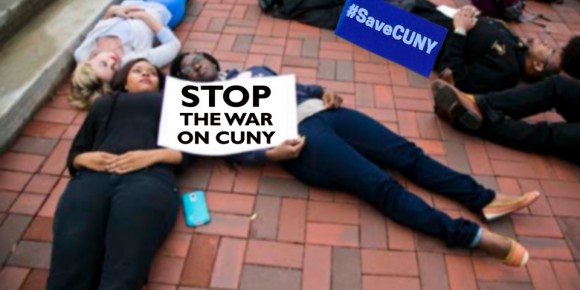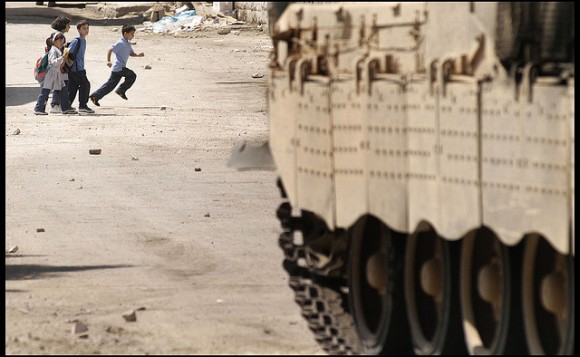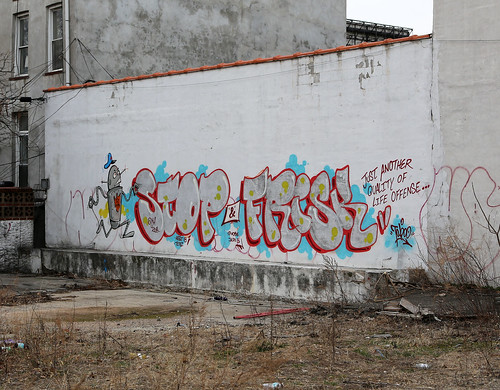[Cross-posted at CUNY Struggle.]
On Thursday, March 24th, the Professional Staff Congress (PSC) staged its second “civil disobedience” of the academic year, this time a die-in in front of the building that holds Governor Cuomo’s New York City office. Like its “blockade” of the entry to the building that holds CUNY’s central offices last November, the PSC trained participants who volunteered to risk arrest, and the NYPD dispatched those arrested to central booking, where they were released shortly after—the whole action a smooth operation carefully production-managed for maximum positive media exposure and minimum duress for participants. What couldn’t be controlled, of course, was the reaction from observers, inside and outside the PSC, which ranged from adulation for those arrested to revulsion that the PSC once again colluded with cops to enact another fake civil disobedience (or civil disobedience “lite”), at a moment when many rank and filers would like to see the PSC hold a strike: a genuine civil disobedience, given the Taylor Law.
Count us among the repulsed. Not only is normalizing the structural role of police, a repressive state apparatus, in this stagecraft deeply reactionary, it also elides the myriad ways the police—and the prison-industrial complex for which they serve as the front line—interfere in the lives and livelihoods of CUNY students and workers who are black and brown. Too, this elision amounts to a significant contradiction in the PSC-leadership-led contract campaign’s tirelessly stated assertion that a new, fair contract is good for CUNY students (as some people who got arrested at the die-in offered as well).
Although a kind of realpolitik claim has it that making people comfortable with the police is vital to ensuring their participation in this type of action, and, therefore, such collaboration with the police should be excused, the very notion of making people comfortable with the police inverts the reality that non-voluntary interactions with the police, such as being arrested for an alleged crime, are not comfortable—and they’re not designed to be comfortable (per the police’s repressive role). Further, the police routinely terrorize, harass, arrest, and incapacitate black and brown people as a function of white supremacy, capitalism, settler colonialism, and imperialism. CUNY students are not excepted from this experience: whether commuting to class, walking around campus, or participating in student clubs and activism, they face both uniformed and undercover officers, and stop-and-frisk, broken-windows, zero-tolerance, surveillance, and other forms of policing. None of this is comfortable for students, nor for anyone who experiences contact with police.
Indeed, to make people comfortable with the police is exactly what the ruling class wants. Not only does such socialization play into the dominant “bad-apple” theory—that only a small number of police officers kill or brutalize people, when in fact every one of them is trained to repress—but it redirects attention from the masses of people negatively affected by the police to the individual person choosing to be arrested, and to be arrested in a positive context. (Selfies with your arresting officer may be the best example of this celebratory mood.) In sum, if the PSC leadership and those arrested—and those praising those arrested—actually took seriously student issues, as they claim, they wouldn’t be colluding with police in any fashion but, instead, organizing to get cops off CUNY campuses, among numerous other issues and actions that would reduce contact between the police and students, on campus and off, and challenge policing and carcerality overall.
Meanwhile, the specific die-in component of the action raises two points of concern: (1) the significant revision of the political history and contexts that obtain in the die-in as a form, and (2) the implications of personifying an institution as the subject of death rather than the people who are subject to death.
In the first case, the image at the top of this post exemplifies some of the revision: originally a photo of a Black Lives Matter die-in at Emory in December 2014, it was altered to (a) replace the “Black Lives Matter” message on the center placard with “Stop the War on CUNY” and (b) add a second placard with the hashtag “#SaveCUNY.” Although the revised image isn’t an official PSC one—a student organizer made and circulated it—it highlights, as with the normalizing of the police above, a shift in attention from the very real deaths of black people by the state and its accomplices to the metaphorical death of CUNY.
As such, the image—and the die-in itself—erased anti-black state violence as a point of struggle in favor of not just a university, which isn’t subject to violence, but one that, like all institutions of higher education in the U.S., is enmeshed in anti-black state violence (again, via various security apparatuses, but also in various forms of institutional violence, such as the low numbers of black students and faculty at CUNY, particularly at the graduate level). In effect, the PSC’s die-in turned attention away generally from the material realities of black students, faculty, and staff, while the altered image circulated to promote the die-in specifically exploited black people and black struggle for a struggle—to “save CUNY” from “dying”—that isn’t particularly focused on race or racism at all (notwithstanding a few signs at the die-in declaiming that “CUNY is about racial & economic justice“).
Further, insofar as the PSC die-in didn’t reference material but metaphoric death, it suggests that the die-in has reached such a point of institutionalization that it’s no longer a useful form of protest—indeed, that, as a form, it’s become completely depoliticized and, therefore, uncontroversial for a liberal organization like the PSC to stage. It bears remembering that the original die-ins by ACT-UP in the late 1980s occurred in a moment of utter silence from the media and government about the epidemic of AIDS deaths, and that the die-ins were meant to break that silence (consonant with ACT-UP’s slogan, “Silence = Death”). And, importantly, the political funerals that began in 1992 took the die-in a step further, presenting death both materially and symbolically, thus ratcheting up the intensity of the tactic as the struggle demanded it.
In contrast, the issue at the center of the PSC die-in—CUNY funding, specifically Cuomo’s proposed $485-million cut—had been widely covered in the media and the focus of much state-government activity by the time of the action: there was no silence to break. Moreover, unlike the gay and queer men who took part in the ACT-UP die-ins and political funerals and the Arab, Muslim, and black people who take part in Palestine-solidarity or BLM die-ins respectively, the people who participated in the PSC die-in had no literal relationship to the death they enacted because it was only metaphoric. Instead, like non-black or -brown folks who jump at the chance to participate in die-ins, thus erasing, visually, their highly differential connection to the death being represented, the PSC members who staged the die-in erased the question of material death entirely in service to pure spectacle. As such, the die-in also reinforced that the PSC contract campaign and related initiatives vis-à-vis state funding have been largely designed to engage the media (“#StopStarvingCUNY”) and not, for instance, CUNY students, faculty, staff, and community who might actually be starving because of low wages or unemployment.
Finally, given the lack of death as material referent, and beyond the cultural dominance of metaphor as a form of comparison, why frame CUNY as dying at all? For one thing, as Fred Moten and Stefano Harney, authors of The Undercommons: Fugitive Planning & Black Study, said at last May’s Cultural Studies Association conference, also employing metaphor, the university is already dead: it’s not working for most people, a claim that, at CUNY, might be supported by the dismal graduation rates of CUNY undergraduates (a fact buried in recent professor op-eds about the importance of CUNY to reducing inequality) or barriers to access in the first place, such as the school-to-prison pipeline, the disinvestment of public primary and secondary schools, or high-stakes testing. In other words, maybe CUNY’s “death,” already or imminent, is actually a good thing: the end of the fiction of the “CUNY Value,” whether promulgated by the administration or faculty, and a new focus on the needs of would-be CUNY students in order to get their paper and thus have a greater chance to self-determine their lives.
Taking the PSC die-in on its own terms, though, what does it mean to personify an institution and mourn its “death,” backed by the not-insignificant resources of the union, instead of centering and supporting with those resources the people of the institution who are subject to, in CUNY professor Ruth Wilson Gilmore’s formulation of structural racism, “the state-sanctioned or extralegal production and exploitation of group-differentiated vulnerability to premature death” (Golden Gulag 28)? Relatedly, what does it mean to stage a civil disobedience in which the “penalty”—a tap on the wrist legally—is as symbolic as the action, instead of engaging in the actual civil disobedience of going on strike and breaking the Taylor Law, in which the penalty is significant (lost wages, fines, possibly lost jobs for individuals; fines and other reductions in resources for the union proper)?
The PSC leadership and many of the union’s most ardent champions, on hand at or who participated in the die-in, prefer the empty symbolism, self-interest, and low stakes of the former approaches—the reasons, not incidentally, the contract campaign hasn’t produced any results yet—while many of us uniting under the “CUNY Struggle” banner favor the material meaning, collectivity, and risk-reward ratio of the latter approaches.
Indeed, to use the PSC campaigners’ enthusiasm for death metaphorics, many of us would like to see this current formation of the PSC, and its incredibly narrow and dispiriting strategy, die and a new, genuinely social-justice-oriented one, replace it. Change requires change. Once a form, like the die-in, or a leadership, such as that of the PSC, becomes institutionalized—dead—it should be discarded.




